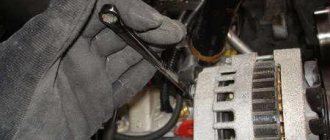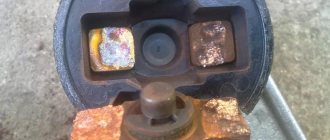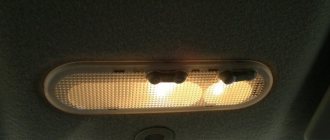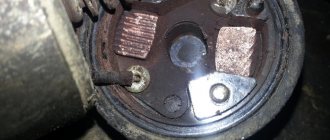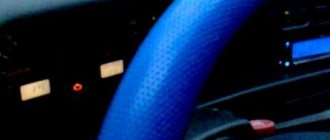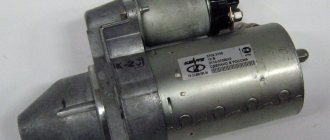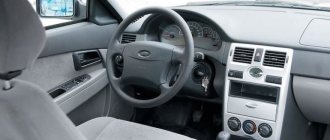02/04/2022 6,852 VAZ 2112
Author: Ivan Baranov
The starter device is considered one of the main mechanisms of the ignition system in any car, and domestically produced cars are no exception. If this unit breaks down, the driver simply will not be able to start the engine, and accordingly, full operation of the car will be impossible. For what reasons does the starter not turn in a VAZ 2112 and how to change this device if necessary - we will talk about this below.
[Hide]
The starter clicks but does not turn VAZ 2112
The starter clicks but does not turn VAZ 2112
In a situation where the starter on a VAZ 2112 does not turn, there may be several reasons that led to its malfunction.
The battery is discharged, which is often observed after parking the car on weekends when it is not being used.
Determination of the battery leakage current at rest. After standing for a long time, the starter may not turn, because the entire battery charge was wasted due to leaks.
Here, most likely the culprit is a large current leak in the electrical system, if this is not due to forgotten dimensions. open doors or trunk lid when the battery is drained by a real current consumer. In such cases, you should charge the battery and simultaneously check the amount of charging current supplied by the generator.
When the starter clicks but does not turn the VAZ 2112, there may also be several reasons, which can initially be determined by ear by external signs.
So, if when you turn the ignition key to the “start” position, you hear frequent clicks from the starter, then again the culprit is a discharged battery, poor contact at its terminals, or a bad ground on the starter.
If only one but distinct click is heard, then in this situation the power contacts of the starter solenoid relay are most likely burnt out. which are not able to conduct all suitable voltages. The next reason why the starter on a VAZ 2112 does not turn when the starter clicks once may be a malfunction of the starter electric motor itself or its drive.
In a situation where the starter clicks but does not turn the VAZ 2112 with a single click, it is necessary to remove the starter from the car and carry out a complete troubleshooting. A complete inspection of the starter will allow you to determine why the starter on the VAZ 2112 does not turn and which of its elements require replacement.
So, when troubleshooting the starter solenoid relay, you need to check its contacts and their condition, which can be done indirectly if the relay is rolled and cannot be disassembled. To do this, without removing the starter from the car, you can check with a device how many volts are coming to the power terminal of the relay (direct plus wire from the battery) and how much is transferred to the second bolt, where the output of the starter motor winding is connected. In the case when the same amount of volts is “transferred” as comes from the battery, then the contacts are working properly and the fault needs to be looked for further to find the reason why the starter does not turn on the VAZ 2112. If, say, 12.7 V comes in, but only 4-5 V is transferred, then the contacts are burnt and require replacement, and if the solenoid relay is not removable, it requires replacement.
However, before making a final conclusion about the malfunction of the retractor relay, it is necessary to check the condition of the starter drive, which can be done when the starter is removed from the car.
Photos of various solenoid relays (shown by arrows) of starters of various modifications.
In the drive, there may be a breakdown of the plug connected to the relay core and this may cause insufficient contact, since the core cannot be fully retracted into the relay winding and reliably connect the power contacts.
After inspecting the drive and the solenoid relay, it is necessary to make a complete inspection of the electric motor, which may contain the following malfunctions. Extreme wear of the brushes or commutator plates on the starter armature, inter-turn short circuit of the windings or their breakage, and brush springs may also require replacement, which no longer provide their guaranteed pressure to the lamellas of the armature commutator.
The inspection will not be complete if you do not check the condition of the gears and their teeth in the gearbox, the condition of the overrunning freewheel, as well as the condition of the cermet bushings. in which the starter armature rotates. Often a crack appears on the outer gear ring of the gearbox. which leads to a malfunction of the starter and serves as a failure in its operation. A set of reduction gears is commercially available and replacing it does not require any special knowledge or skills.
From the review you will learn what to do in case of a classic problem, when everything is fine in a VAZ 2111 car, but the starter refuses to work.
VAZ 2110 starter brushes
Everything you need to know about the VAZ 2110 starter brushes, from checking their functionality to replacing them with new ones.
The starter on the VAZ 2110 does not turn well.
The article discusses the main steps that need to be taken if the starter on the VA 2110 begins to turn poorly.Home page About the site Write to us Advertising on the site © 2012 AUTOGREP “auto Russia” All materials presented on the site are protected by copyright (see Chapter 70, Part 4 of the Civil Code of the Russian Federation). Use of site materials in printed publications or on the Internet is possible only with the permission of the site owner. (c) autogrep.ru.
https://autogrep.ru
legkoe-delo.ru
Types of starter breakdowns and the reliability of its components
Since the starter is an electromechanical device, all its breakdowns can be divided into two categories:
- mechanical type (wear of rubbing parts, deformation or jamming of one of the starter elements, etc.). Eliminating these breakdowns requires removing the unit from the machine;
- electrical type (problems with battery voltage supply, rupture or short circuit of the stator windings or starter armature, burning of contacts or working surfaces, etc.).
Of course, the easiest thing would be to carry a spare unit with you. But it is quite bulky and massive, and also costs a lot of money. So, for the cheapest starter for a VAZ car you will have to pay at least 3 thousand rubles, and for a foreign car of the same class - 6 thousand rubles.
Moreover, as practice shows, in 90% of cases, starter problems are associated with faulty wiring, brush mechanism, solenoid relay or battery. Eliminating the noted deficiencies will cost much less, although some of them will require a stand.
If we rank the malfunctions of the average passenger car starter, then the frequency of breakdowns of its components and parts decreases in the following order:
- brush commutator;
- front and rear bushings;
- armature shaft;
- planetary mechanism (if any);
- stator winding;
- Bendix with overrunning clutch;
- flywheel crown teeth.
why would this be and what should I do about it?
VAZ 2112 does not start, the starter does not turn with the key and does not work: causes and solution to the problem
The starter device is considered one of the main mechanisms of the ignition system in any car, and domestically produced cars are no exception. If this unit breaks down, the driver simply will not be able to start the engine, and accordingly, full operation of the car will be impossible. For what reasons does the starter not turn in a VAZ 2112 and how to change this device if necessary - we will talk about this below.
Content
[ To uncover]
[Hide]
Possible starter malfunctions: causes and symptoms
The main components of the mechanism
So, first, let's look at the faults that cause the starter to not turn on a VAZ 2112.
If the engine does not start, it does not mean that the problem lies in this particular device, so first you need to make sure that the problem does not lie in a discharged battery:
- If, when trying to start the VAZ 2111 starter with the key, the crankshaft turns once or frequent clicks of the device are heard, this is indicative of a low battery. Also, the reason may be poor contact of the terminals with the battery or disconnection or poor contact of the mechanism ground.
- If, when starting the engine with the key, you heard only one click, but the starter does not turn, and therefore the engine does not start, most likely the problem lies in burnt power contacts. In particular, we are talking about the retractor relay mechanism. Due to burning, these contacts will not be able to conduct voltage through them. It also happens that when starting the engine with the key on a VAZ 2112, the starter does not turn, but the contacts are intact; if this is the case, then the reason should be sought in the non-working electric motor of the mechanism or its drive.
- The appearance of uncharacteristic noise during operation of the device may be due to wear of the bushings of the bearing devices. In addition, the reason may lie in the wear of the journals on the armature shaft.
- It is necessary to check the quality of fastening of the device. It is quite possible that problems in its performance are due to loosening of the screws. It must be taken into account that vibrations can negatively affect the functionality of the mechanism.
- The reason may also be damage to the drive teeth (the author of the video is the Lexin channel).
Final diagnostics of the starter before replacement
If the starter on a VAZ 2112 does not allow you to start the engine, before starting repairs, you should carry out a full diagnosis of the device. First you will need to open the hood and remove the air
auto21rus.ru
Examination
VAZ 2110 stove smell
To check the stove, you should:
- To do this, you need to open the hood and install a support stand.
- Inspect all connected parts for leakage of antifreeze in the engine cooling system.
Note: When the vehicle engine is running, the coolant supplied under pressure heats up.
- Pull the clamps securing the pipes.
- Clean the places where antifreeze leaks on parts of the engine, put it into operation.
When starting it clicks, but the starter does not turn
One day you sit behind the wheel of your car, insert the key and try to start the engine. But suddenly the unexpected happened - something clicks under the hood, but the starter does not turn. That is, there is no whistling sound after which the vehicle engine starts working. This means that there is a problem somewhere in the starting system.
First, let's figure out what these clicks are and where they come from. This sound is made by the starter traction relay. It has a retracting and holding winding. When the key is turned to the start position, the first of them begins to retract the relay core. But the holding winding releases it due to lack of voltage. This is what causes the clicking sound. And as a result, the starter does not turn the engine.
Well, now you need to figure out why the traction relay cannot perform its assigned function. The first step is to carry out a diagnosis by ear: only a single click is heard, after which there is silence, or the sound is constant. It is very important. Based on such simple diagnostics, you can significantly narrow the scope of troubleshooting.
If it constantly clicks, but the starter does not turn, then the reason for this may be:
— Low battery. To fix the problem, you need to charge it.
— Poor mass of the body with the power unit. In this case, it is necessary to check the corresponding contacts and the reliability of their connections. If they are oxidized or dirty, they should be cleaned with sandpaper. You can also lay additional ground wire.
— Poor contacts at the battery terminals.
In many cases, the problem with lack of voltage can be predicted. For example, when the starter spins for a long time when starting the engine, you should look for the reasons for this behavior. It is possible that the source of poor starting lies in the battery or wires.
If, after turning the key, it only clicks once, but the starter does not turn, then in this case the cause of the malfunction may be:
- poor engine mass;
— unreliable connection of the traction relay with the starter or charring of their contacts;
- in the starter.
Troubleshooting should be carried out in the same sequence as suggested above. That is, first check the engine mass and the reliability of the connections. If the reason lies in them, then the starter will not have to be removed. Otherwise, you cannot do without dismantling. In this case, the following breakdowns of the starter are possible, which do not allow the starting system to work properly:
— the wire running from the traction relay to the starter windings burned out;
— the starter brushes are worn out;
— the starter bushings are worn out;
- a short circuit has occurred in the armature windings;
— there is a break or short circuit in one of the starter windings;
— the Bendix drive fork is deformed or broken;
— grooves appeared on the Bendix teeth.
For these reasons, there is a clicking noise under the hood of the vehicle, but the starter does not turn the engine. In most cases, it is very easy to return the car to functionality by checking the electrical system and eliminating any identified defects. If the reason lies in a malfunction of the starter itself, then in this case it will have to be repaired or replaced with a new one.
fb.ru
We close the starter in the French special cases
Lada Priora Sedan Logbook Preparing for winter. Starter
Access to the starter is always open from under the bottom - you just need to remove the crankcase protection. An example is in the photo below.
Under the bottom of Renault Megane 2
It is difficult to reach the starter from the engine compartment. In the best case, it is closed by a filter (VAZ), in the worst case, by a battery. You can remove the filter, but what about the battery?
Starter installation location (circle)
Everything is done so that the starter can be changed, repaired, but not short-circuited.
What does terminal S look like?
On Renault cars, the terminal looks like a threaded outlet. The nut screwed onto it is “white”, although it itself is made of copper (see photo).
Starter Renault Logan, phase 1
We have already talked about the VAZ - they use a plug. If you remove it, you can see the “petal”.
The starting method using a screwdriver is not the best. The problem is limited access.
50 Amps
We are going to short-circuit the starter with a screwdriver, but at the connection points where the current will flow, it may “stick”. In this case, without unnecessary panic, remove the negative terminal from the battery.
To remove the minus terminal, you need a 10mm open-end wrench. Keep it with you.
The starter clicks but does not turn - the reason? Let's figure out why the starter doesn't turn
The starter is a complex electromechanical unit, without which your car is nothing more than a pile of iron. No, of course, you will be able to start the car in some alternative way, but that’s a completely different story. Often the starter, whose task is to start the engine, malfunctions and fails, after which either the starter clicks but does not turn, or the starter does not turn at all, which is even worse.
Reasons why the starter clicks but does not turn
Often the cause is emergency or improper braking, in which the starter, which is engaged with the flywheel, receives a large current. The starter itself is a short-term electrical unit, so if it operates for a long time, it may fail, which in most cases manifests itself in the form when the starter does not turn or the starter clicks but does not turn.
In order to understand why clicks occur and there is no rotation, you need to pay attention to how the starter is designed.
The starter contains a so-called traction or, as it is also called, retractor relay, which looks like a small cylinder attached to the base of the starter. The starter relay, in turn, is equipped with a pull-in and holding winding. Failure occurs precisely at the moment when a voltage deficiency occurs on the holding winding. The task of the retracting winding is to retract the core, but it returns to its original position because the holding winding cannot hold it. This is exactly what happens when you try to start the car by turning the key in the ignition. And this phenomenon looks to us in the form of clicks, that is, when the starter clicks but does not turn.
As you already know, clicks are produced by the solenoid relay, and there may be several reasons why this happens. Here is a list of the most likely reasons why the starter does not turn, but clicks:
- Rechargeable battery (AB). Most likely, the battery is simply discharged, or is not charged enough, or the terminals have poor contact with the high-voltage wires. Charge the battery and try to start the engine again.
- Poor weight of the body and the engine. In this situation, it is recommended to take another ground wire and try again.
The starter does not turn and one distinct click is heard. In this case, I recommend checking the engine mass, as well as the fastening of the traction relay to the starter housing. The problem may be bad or burnt out contacts on the traction relay. If not, then most likely the breakdown lies in a malfunction of the starter mechanism itself, which cannot be done without completely disassembling or replacing it.
If you are convinced that the reason why the starter clicks but does not turn is the starter itself, here are a few probable reasons why this could happen:
- The power wire connecting the starter winding and the traction relay may burn out.
- Critical wear of starter brushes or bushings.
- Break in the starter winding or short circuit in the armature winding.
- Deformation or destruction of the fork in the Bendix drive.
Let's summarize.
If you notice problems with the starter, do not delay repairs, otherwise at one inopportune moment it will simply stop turning, and according to the “law of meanness” this will happen somewhere far from home or when you are in a hurry... The problem is when the starter clicks but does not turn you can decide on your own. There are an abundance of all kinds of manuals on the Internet for repairing and replacing the starter with your own hands. However, if you are not sure, it is better to trust the professionals, so you can save your time, nerves, and sometimes money.
Video diagnostics and repair of the starter yourself:
How to quickly close the starter with a screwdriver or other means
What to do if the screen on your phone is cracked. What to do if your laptop screen is broken
Many motorists have to deal with problems related to the vehicle starter at least once in their lives. The starter stubbornly refuses to work as before, although it itself is not damaged (the solenoid relay becomes the problem). We will look at what to do in this case and how to revive the starter in our article. There is Murphy’s law, known to all people on earth, as it is also popularly called the law of meanness. The car breaks down at the most inopportune moment, when you urgently need to go somewhere, and time is running out. In this case, there is nothing left to do but close the starter contacts in order to revive this important element of the car.
Do-it-yourself VAZ 2110 starter repair, what to do if it clicks but does not turn, the device
It is no secret that it is impossible to start a car without a starter. Therefore, his condition should always be treated with increased attention. If it was not possible to save the element, then it is quite possible to carry out the repair yourself. It will be much cheaper than going to a service station.
First, study the VAZ 2110 starter from the photo, which will allow you to get a first idea about it. Don't worry if you've never even seen this element. This is not a hindrance to understanding the device.
It may have two problems - a complete breakdown that requires replacement, or it simply does not turn the engine. We will consider each issue separately in order to understand the causes and methods of eliminating the malfunction.
Doesn't it turn?
Device diagram
If the starter on an injection VAZ 2110 does not turn, there may be several reasons for this.
- The culprit is the solenoid relay. If you insert the key, turn it, the instrument panel lights up, the fuel pump turns on, but when you turn it further, the panel goes out and the starter does not turn on, you should check the solenoid relay. Make sure there is voltage in it. Try closing the starter, turning off the alarm, which can also cause problems. If everything works separately, but in the end the starter does not turn on, then the reason is in the solenoid relay. It needs to be replaced with new ones and the problem will disappear.
- Overrunning clutch does not work. You started a cold engine, drove a couple of tens of kilometers, stopped to get out for a couple of minutes, returned, and the starter clicks, but does not turn on your VAZ 2110. Only when the car cools down, you manage to start the engine. First of all, the overrunning clutch, or popularly Bendix, is to blame. Replace it with a geared analogue. Additionally, check the wires that go from the Bendix to the battery.
- There are no contacts. The starter starts, but it is very difficult, making a lot of clicks. If the situation repeats regularly, be sure to check your contacts. The terminals are probably oxidized. Cleaning didn't work? Then check the ground contact with the car body and the starter contacts. For them, oxidation is a natural phenomenon. Another way is to ask a friend to turn the key in the ignition, and then hit the relay with a hard object a couple of times. If the car starts, then the closing contacts are simply stuck. But here it is better to completely replace all the relays than to repair and disassemble the unit.
- The problem is in the immobilizer. It is not uncommon for the starter activation circuit on the injection VAZ 2110 to be disrupted due to the immobilizer. The engine may suddenly stall, the starter stops turning, and it is not possible to start it even with a push. The terminals are clean and the battery is charged. If the immobilizer is turned on, this may be the cause. Due to the protection being triggered, the engine does not respond. You will no longer be able to start the car, so call a tow truck and go to the nearest service station.
- Problematic injector. We have examined almost all starter problems characteristic of a carburetor engine. But today the “tens” are injection ones. They don’t really like low-quality fuel, which VAZ 2110 owners so often like to refuel with. Therefore, the starter may not work for the simple reason that the injector is clogged or dirty. By performing a flush, you will eliminate the problem.
Main causes of malfunction
Problems
Minor or partial repairs will not always save the situation. But before removing the starter from the VAZ 2110, we recommend that you familiarize yourself with the main reasons for its failure, which serve as a reason for replacement.
Replacing the unit
Now another question arises - how to disassemble it? There shouldn’t be any particular problems with this matter if you arm yourself with the instruction manual and also read our recommendations.
Arm yourself with a set of keys for 10, 13, 15 and 8 millimeters. Actually, you don’t really need anything else in terms of tools.
Replacement
The sequence of dismantling and repair is as follows:
- Drive the car into the pit or lift it using a lift. You must have access to the underside of the car.
- If you have just arrived, give the engine some time to cool down. It is better to work with a cold engine.
- Remove the negative cables from the battery.
- First remove the protection and then the tin casing that protects your gearbox. To do this, you will need two keys - 8 and 10 millimeters.
- The power wire plug is removed from the starter. You just need to pull it towards yourself a little.
- Now take a 13 mm wrench and use it to unscrew the power wiring located on the solenoid relay.
- Place the loose wire aside and secure it with something temporarily so that it does not interfere with further repairs.
- The starter is attached to the gearbox housing with two nuts. They are easily loosened with a 15mm wrench. If you have problems unwinding, lubricate the fasteners with the almighty WD40.
- Dismantle.
- Now check the condition of the bushings on the gearbox housing.
- Make sure that the armature shaft is in good condition; when moving, there should be no play or jamming. If such defects occur, then it is recommended to immediately replace the bushings with new and high-quality ones.
- There are always two bushings. One is at the bottom of the starter, and the second is on the gearbox housing. The bushing on the starter can be changed without any problems, but difficulties may arise with the second one. To dismantle it, you need a special tool called a rubber. It is better to entrust the work to specialists from a service station.
- If the cause of the starter malfunction is the bendix or the solenoid relay, there is no need to call the experts for help.
- To remove the relay, unscrew the power wire, or rather its fastening, from the starter housing. You will need a key for 13.
- Using a size 8 wrench, remove the two bolts securing the relay to the starter housing. It is important to be careful here, because when removing the bolts, there is a spring in the relay that can spring back. Hold it with your hand when dismantling.
- Remove the relay piston from the rocker arm hook located on the bendix.
- Proceeding in reverse order, install a new relay.
- If you need to replace the bendix, then remove the solenoid relay, unscrew the two bolts with a 10mm wrench at the back of the starter. Now disconnect the starter housing from the front of the starter where the bendix, rotor and fork are located.
- Use a flathead screwdriver to pry up the plastic fork to remove it from the armature, and remove the armature itself and the bendix from the front of the body.
- Remove the retaining ring located on the tip of the armature and remove the desired bendix.
- The structure can be assembled in the reverse order, but the splines must first be lubricated with Litol.
- Test the new starter in place before beginning installation. To do this, connect the power terminals of the battery.
- The nuts responsible for fastening the terminals are tightened with a 13mm wrench. But it is not recommended to apply much force, since the terminals are made of copper. Clamping too hard will damage the threads, causing even more problems.
We figured out how to disassemble the starter on a VAZ 2110 and we can say that this procedure is not particularly simple, but it does not require mandatory execution by a professional auto mechanic.
The starter on the “ten” is somewhat capricious, but if you operate the car correctly, check the condition of the contacts, and also periodically flush the engine on the injection VAZ 2110, it can last a long time and reliably.
luxvaz.ru
Types of starter breakdowns and the reliability of its components
Since the starter is an electromechanical device, all its breakdowns can be divided into two categories:
- mechanical type (wear of rubbing parts, deformation or jamming of one of the starter elements, etc.). Eliminating these breakdowns requires removing the unit from the machine;
- electrical type (problems with battery voltage supply, rupture or short circuit of the stator windings or starter armature, burning of contacts or working surfaces, etc.).
Of course, the easiest thing would be to carry a spare unit with you. But it is quite bulky and massive, and also costs a lot of money. So, for the cheapest starter for a VAZ car you will have to pay at least 3 thousand rubles, and for a foreign car of the same class - 6 thousand rubles.
Moreover, as practice shows, in 90% of cases, starter problems are associated with faulty wiring, brush mechanism, solenoid relay or battery. Eliminating the noted deficiencies will cost much less, although some of them will require a stand.
If we rank the malfunctions of the average passenger car starter, then the frequency of breakdowns of its components and parts decreases in the following order:
- brush commutator;
- front and rear bushings;
- armature shaft;
- planetary mechanism (if any);
- stator winding;
- Bendix with overrunning clutch;
- flywheel crown teeth.
VAZ 2110 starter clicks but does not turn
starter repair, partial. mini photo report.
2110. Repair and. How. Do-it-yourself VAZ 2107 suspension repair.
Re: Solved: When you turn the key, the lights go out, but the starter does not turn.
What is the difference between camshaft 2108 and 2110?
VAZ won’t start Video on the Zaporozhye portal.
If the starter starts with great difficulty, and before it starts...
VAZ 2110 starter diagram.
Selling underseat boxes for VAZ 2110-12.
Man starter, Man generator, Man generator, Man starter.
It is important to remember that.
The starter turns but...
went to the car, mine. looked at the picture. starter. on the car market for 3.5 ki...
2109 does not start, when you turn the key there is one click, the starter is silent, I pull it in...
VAZ 2110 starter repair.
The starter does not turn, only clicks VAZ 2110.
The starter does not turn.
Defective starter parts.
Tank neck of VAZ 21074.
Unfortunately, the situation when the starter clicks but does not turn the VAZ 2106 at.....
VAZ 2110 starter repair.
vaz-2110.net
All features of the standard scheme
The reader will be surprised, but there will be more than one scheme here. The most difficult option is shown below.
Scheme with additional starter relay
Please note: relay K2 is not “unloading” at all. A significant current flows through the lock contacts, and relay K2 can be called “blocking”: when it does not work, the starter does not turn. Why is this necessary, think for yourself.
If an attacker closes the contacts in the lock, he will not only be unable to start the engine, but also not use the starter. That is, the hijacker will not drain our battery.
The circuit shown above is used with 1.6 liter injection engines. There may be another option - a simpler one.
Scheme without additional relay
There is no blocking relay here. The current flows to the solenoid relay from pin 50. A simple version of the circuit is typical for cars from early years of production. Which applies to the entire “Ten” family, including hatchbacks. That is, an interesting combination occurs: the model is VAZ-2112, and the starter will turn even in the absence of all relays and ECUs!
The starter doesn't turn, what happens?
We know that there are two variants of the scheme. If “option 2” is implemented, voltage to the starter is supplied directly from the lock. But the ignition switch in the “Tens” is short-lived, since 30-40 Amperes are transmitted through it (the current of the solenoid relay). This is true for both the sedan and the 2112 hatchback, and the starter may not turn only because the lock is broken. Draw your conclusions!
All of the above also applies to “diagram 1” - look at it carefully.
The main relay is located in the extension block. It is located under the stove on the right. An additional relay is located in the main unit (see photo). However, it may be missing.
Main block
Additional block
If “option 2” is implemented, check only the lock. And if there is an additional relay, it is not recommended to install a jumper instead. Marked in the photo:
- Additional relay (white arrow);
- Main relay (element “6”).
What should I do if the starter clicks but does not turn?
You turn the key in the ignition, the starter clicks, and in response there is silence. Agree, the situation is very unpleasant, but quite common. There are many reasons for its occurrence, but in this article we will focus on one associated with the starter, or more precisely with one of its elements - the solenoid relay (hereinafter referred to as VR).
The nature of the malfunction described here is quite specific. An attempt to start the car's power unit is accompanied by VR clicks, but the starter armature does not turn. Motorists who do not have sufficient practical experience rush to blame all the “sins” on the VR, without thinking that in a situation where the retractor clicks, the starter does not turn, and the start does not occur, any of the elements of the electrical supply system involved in the process may be to blame .
So why doesn't the starter turn?
The chain of elements, the performance of which directly affects the starting of a car engine, consists of:
- Rechargeable battery.
- Starter relay.
- Ignition switch.
- Starter.
- Solenoid relay.
To avoid errors in the process of diagnosing a malfunction, it is recommended to start searching for defects by checking the functioning of the battery. It includes two main points:
- Checking the battery charge, monitoring the complete contact of the battery terminals with the wire tips, as well as inspecting them (the wires) for the absence of fractures (breaks).
- Lack of contact between the power unit and the car body due to insufficient tightening of the connection, exposure to corrosion processes, etc.
So, let's try to figure out the situation when the retractor clicks, but the starter does not turn. Firstly, the situation is far from critical, since at least some “signs of life” are given by the launch system. And, secondly, before dismantling the starter, which in itself is not so simple and quick, try to eliminate some defects that can negatively affect the engine starting process:
- Damage to the wires of the electrical supply system.
- Insufficient contact at the junctions of wires with system elements.
- Malfunction of the ignition switch.
- Loosening of the BP fastening to the starter housing.
Once you have determined that the starter itself is the culprit of the problem, and have removed it from the engine compartment, you need to establish the degree of performance of it and the VR. This is done like this:
- Take a battery whose serviceability is not in doubt, and connect its “-” terminal to the starter housing, and the “+” terminal to the pin located after the BP.
- The operation of the starter will be evidence of a malfunction of the VR, and “silence” will be an invitation for you to look for the cause inside this unit.
Let's consider the possible causes of a starter malfunction, the symptoms of which we defined as “the retractor clicks, the starter does not turn, but clicks”:
- Unacceptable degree of wear of starter structural elements: bushings, brushes.
- Burnout, break in the power wire between the VR and the starter winding.
- Mechanical deformation (complete destruction) of the overrunning clutch drive fork.
- Short circuit between the turns of the armature winding.
- Starter winding broken.
Attention! If an attempt to unsuccessfully start the engine is accompanied by just one click, the reason lies in the lack of “ground” in the power unit housing, the lack of contact at the BP terminals or its loose fastening.
Reasons for difficulty starting a car in cold weather
Novice drivers are interested in the question of why the car does not start in cold weather. There are plenty of reasons: problems with the battery and starter, an increase in lubricant thickness, disruption of the fuel supply in the system, as well as the use of summer grades of diesel fuel in diesel cars.
Battery problems
The battery is the main culprit for problems with starting a car in cold weather, especially if the battery has been actively used for more than 3 years - at this time its power begins to decrease. In addition, particles of rust and dirt accumulate on the battery terminals over time, and oxidation of the terminals and contacts can be caused by temperature fluctuations: when the motor is turned off, the wires have the same temperature as the environment, and at the moment of starting they begin to heat up. This process leads to a gradual breakdown of the integrity of the connections.
Chemical processes inside the battery slow down at sub-zero temperatures: already at -15...-20°C it operates at only 40% of its potential even when fully charged - this is another reason for problems with starting the engine.
Starter malfunction
It is not uncommon for the starter to break down in winter. This unit is subject to critical loads in cold weather due to:
- thickening of lubricants;
- freezing of moving parts of parts due to condensate freezing on them;
- changes in resistance at the contacts.
All this leads to an increase in the current flowing through the armature, which causes incorrect operation of the unit, and sometimes even destruction of the armature, starter brushes, and commutator lamellas.
Thickened motor oil
At subzero temperatures, lubricants tend to become thicker, which increases resistance in rotating and moving mechanisms. This, in turn, increases the load at the starting moment on the battery, which is also cooled, as a result of which the battery discharges faster. Using special winter brands of oil can partially solve the problem.
The coolant also works only in the temperature range specified by the manufacturer; when this indicator decreases, it freezes. At the same time, the starter will continue to rotate, which often causes breakdown of the entire unit and makes it impossible to operate the car. To avoid this, use coolant designed for the appropriate climate conditions.
Bad gasoline or its supply is interrupted
The use of low-quality fuel also becomes a problem. The drops of moisture contained in it, freezing, form ice plugs that prevent the normal flow of the mixture into the combustion chamber. You can prevent trouble by using high-quality fuel or specialized additives.
In cold weather, the operating parameters of fuel pumps deteriorate, which leads to problems in the functioning of injectors and nozzles. Misfire may occur in some or even all cylinders.
The ignition system is misregulated
The main “winter” enemy of the fuel system, which causes its imbalance, is moisture entering the unit in the form of condensate. It freezes at sub-zero ambient temperatures, preventing the flow of the fuel-air mixture.
Spark plugs flooded
In winter, it is necessary to use proven spark plugs; it would be a good idea to change them in the off-season, before the first cold weather begins, and also have a spare set of spark plugs with you. In addition to the general problems that can arise at any time of the year, there is also a typical “winter” problem - the candles are flooded with fuel.
In the cold, the formation of a combustible mixture requires a change in conditions. In frosty air, the concentration of oxygen is increased, and accordingly, more gasoline will be needed, and the command to increase the fuel supply is sent by the electronic control unit to the injector nozzles. A cold starter produces a weak spark, and meanwhile the injectors continue to supply fuel to the system, which fills the spark plugs.
The use of summer diesel fuel in diesel cars
A diesel car may not start in winter due to the use of the wrong fuel. Summer diesel fuel - a special type of diesel fuel - can only be used at an ambient temperature of at least -5°C, because already at -6°C it becomes cloudy and thick, and at -7... -8°C it begins to solidify.
The crystals formed in this process:
- the fuel filter is clogged;
- accumulate in the heat pipe;
- damage the engine and other components of the mechanism.
If it is not possible to use winter fuel, you should definitely use special additives for diesel fuel.
Why does the smell of antifreeze appear in the cabin?
Sometimes an unpleasant odor appears even with normal sensor readings. Ventilating the interior gives a temporary result - when the window glass is lifted, the problem manifests itself again. To completely solve it, you will have to establish its source.
Typically, the cause of the odor is an antifreeze leak. The cooling system mechanisms fail as a result of prolonged use. The expansion tank itself could be depressurized or initially be of poor quality.
